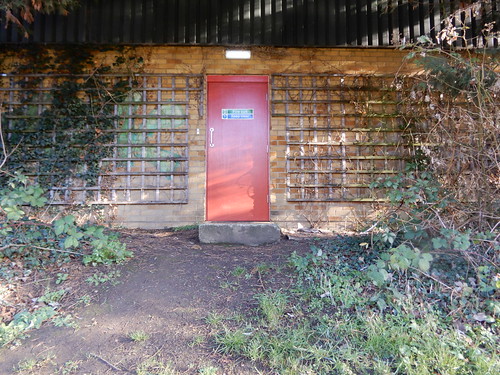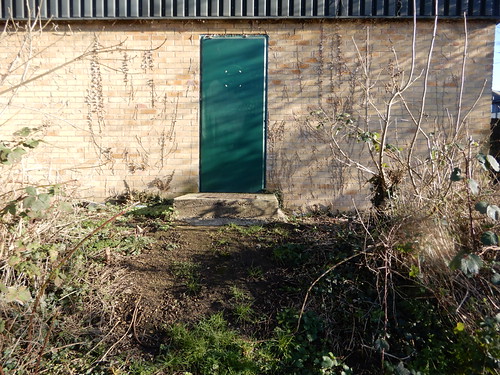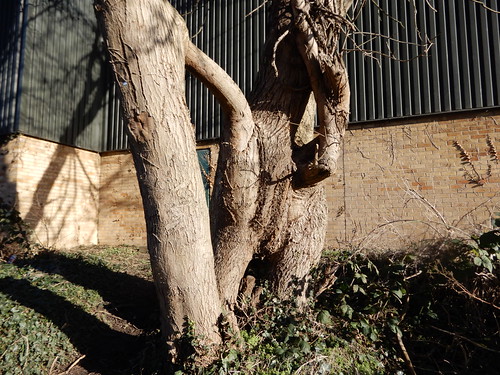The tips are closed, and garden waste collections have been halted - not essential. The two bags of formerly green, now very brown, waste that I have lurking in the shed will need to be moved to accommodate an exercise bike. And yet, we will all be spending a lot more time in the garden. Mine's already looking quite a lot tidier. But I'm not getting rid of any of that waste!
So let's start the experiment. First stop - the vine, with its half-alive, half-dead bendy stems, that need a bit of . The Winter Jasmine, which at this time of year puts on a massive growth spurt. Let's cut need for garden string and wire to a bare minimum:
Then there's the Passion Vine, as usual half dead and all up in the wrong places. Normally I'd cut off all the dead bits and discard, and tie in all the live bits, but this often leads to all the live bits dying in April cold snaps. so this year I'm going to keep the dead stuff and wind that in with the live so it gets a bit of protection:
Then I need to trim back the Douglas Fir and Cherry Laurel privacy hedge installed by my back neighbour. I like this hedge, but in its place. This would normally give me a bag of somewhat sour clippings; both Douglas and Laurel leaves decay slowly and foul the ground for other plants. But, they are great shelter for insects - hordes of lovely ladybirds hibernate in them every winter. So, meet my hedge clipping high rise bug hotel. Bonus - the flexible Laurel and Fir twigs are great for anchoring back the Passion Vine stems and may even shelter the plant a bit:
I've been in this garden for a few years now, and as for all paved/bed gardens, the beds are drifting upwards, mounding up into informal raised beds. Next to the compost bin, where worm action is at frenzy level, the problem is so bad that I'm using my Grape Vine prunings to make a cosy ad-hoc raised bed for my potato vine:
They won't last, of course, but that's hardly the point; there will be always be more twigs and trimmings to replace the ones I used today. They might sprout as the sap rises, but is that a bug or a feature? Time will tell. But bet you're thinking, ah, ah now. What about those devils of the garden, the perennial weeds? Well, my bindweed has well and truly landed for the season. So I made it into a hat for my water butt:
There we go, zero waste garden session achieved for today. Oh, and here's one I made earlier:
There was an old dead Passion Vine stem that needed clearing growing over a battered garden arch in the wrong place. Tim & I shifted it over a bench, stabilising the rotting arch with cut Hazel suckers, spare bamboo and wire, and then I wove in the old Passion Vine, some dead, some alive, some blackcurrant, a bit of Honeysuckle, some Red Jasmine, and hey I'm pleased with this.
So let's start the experiment. First stop - the vine, with its half-alive, half-dead bendy stems, that need a bit of . The Winter Jasmine, which at this time of year puts on a massive growth spurt. Let's cut need for garden string and wire to a bare minimum:
Then there's the Passion Vine, as usual half dead and all up in the wrong places. Normally I'd cut off all the dead bits and discard, and tie in all the live bits, but this often leads to all the live bits dying in April cold snaps. so this year I'm going to keep the dead stuff and wind that in with the live so it gets a bit of protection:
Then I need to trim back the Douglas Fir and Cherry Laurel privacy hedge installed by my back neighbour. I like this hedge, but in its place. This would normally give me a bag of somewhat sour clippings; both Douglas and Laurel leaves decay slowly and foul the ground for other plants. But, they are great shelter for insects - hordes of lovely ladybirds hibernate in them every winter. So, meet my hedge clipping high rise bug hotel. Bonus - the flexible Laurel and Fir twigs are great for anchoring back the Passion Vine stems and may even shelter the plant a bit:
I've been in this garden for a few years now, and as for all paved/bed gardens, the beds are drifting upwards, mounding up into informal raised beds. Next to the compost bin, where worm action is at frenzy level, the problem is so bad that I'm using my Grape Vine prunings to make a cosy ad-hoc raised bed for my potato vine:
They won't last, of course, but that's hardly the point; there will be always be more twigs and trimmings to replace the ones I used today. They might sprout as the sap rises, but is that a bug or a feature? Time will tell. But bet you're thinking, ah, ah now. What about those devils of the garden, the perennial weeds? Well, my bindweed has well and truly landed for the season. So I made it into a hat for my water butt:
There we go, zero waste garden session achieved for today. Oh, and here's one I made earlier:
There was an old dead Passion Vine stem that needed clearing growing over a battered garden arch in the wrong place. Tim & I shifted it over a bench, stabilising the rotting arch with cut Hazel suckers, spare bamboo and wire, and then I wove in the old Passion Vine, some dead, some alive, some blackcurrant, a bit of Honeysuckle, some Red Jasmine, and hey I'm pleased with this.


















